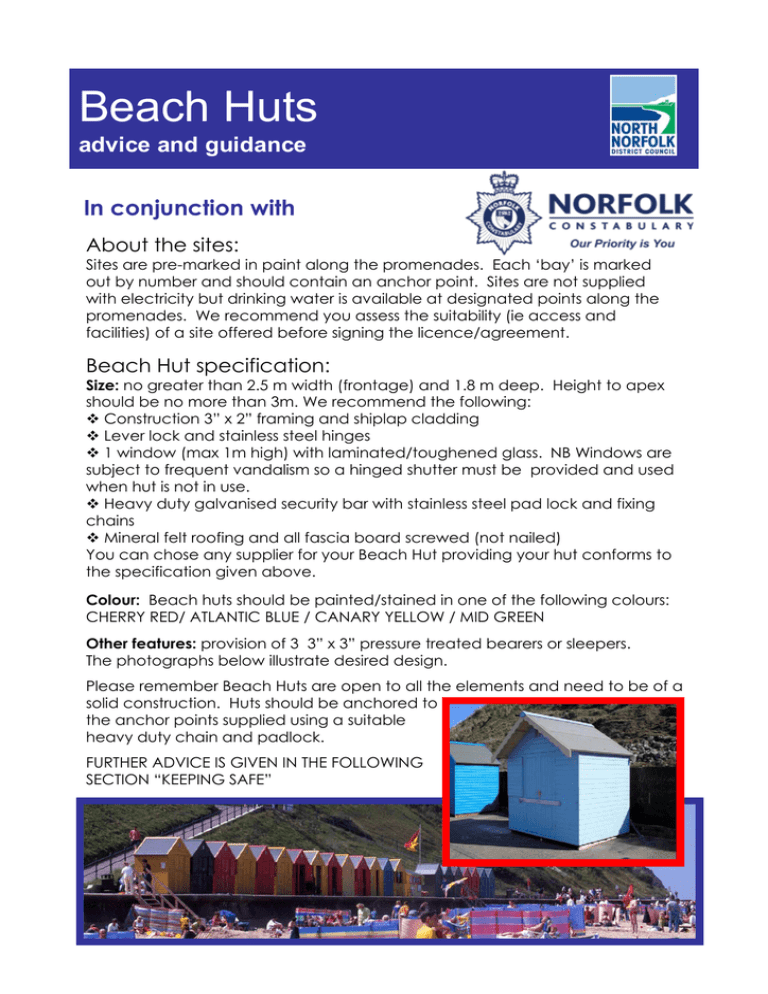Beach Huts advice and guidance In conjunction with About the sites:
advertisement

Beach Huts advice and guidance In conjunction with About the sites: Sites are pre-marked in paint along the promenades. Each ‘bay’ is marked out by number and should contain an anchor point. Sites are not supplied with electricity but drinking water is available at designated points along the promenades. We recommend you assess the suitability (ie access and facilities) of a site offered before signing the licence/agreement. Beach Hut specification: Size: no greater than 2.5 m width (frontage) and 1.8 m deep. Height to apex should be no more than 3m. We recommend the following: Construction 3” x 2” framing and shiplap cladding Lever lock and stainless steel hinges 1 window (max 1m high) with laminated/toughened glass. NB Windows are subject to frequent vandalism so a hinged shutter must be provided and used when hut is not in use. Heavy duty galvanised security bar with stainless steel pad lock and fixing chains Mineral felt roofing and all fascia board screwed (not nailed) You can chose any supplier for your Beach Hut providing your hut conforms to the specification given above. Colour: Beach huts should be painted/stained in one of the following colours: CHERRY RED/ ATLANTIC BLUE / CANARY YELLOW / MID GREEN Other features: provision of 3 3” x 3” pressure treated bearers or sleepers. The photographs below illustrate desired design. Please remember Beach Huts are open to all the elements and need to be of a solid construction. Huts should be anchored to the anchor points supplied using a suitable heavy duty chain and padlock. FURTHER ADVICE IS GIVEN IN THE FOLLOWING SECTION “KEEPING SAFE” Keeping safe: Make sure your beach hut is as secure as possible. Look after your hut! - if a property looks uncared for it is much more likely to suffer from crime or antisocial behaviour – Local police experience and statistics back this up so keep your beach hut in good repair for the sake of you and your neighbour. Keep a regular eye on yours and neighbouring property during the year and report any evidence of it having been involved in crime as soon as possible so that the property can be secured. Early detection and warning may assist in identifying offenders! A beach hut is unlikely to ever be a secure enough environment to keep valuable saleable property overnight. Make sure that you do not keep any valuables in the beach hut and remove any combustibles that are an obvious fire hazard. Police advice on hut specification: The most common point of entry for the thief is via the door. Therefore special attention needs to be given to the door and, just as importantly, the door frame. The frame needs to be as robust as you can afford, hardwood is best and must be securely fixed to the surrounding structure. Coach bolts are better than nails or screws in a building of wooden construction because they can be bolted through both the door frame and the frame of the hut. However, existing frames can be improved by the use of an improved frame fixing. This is really an extra long plastic plug and steel screw which is inserted in to a single hole drilled through the frame into the surrounding structure. It is advisable to use at least four of these to a side. These fixings are also useful to improve the fixing of door ironmongery such as hinges and keep plates. This approach can be useful on narrow door frames of 50mm or less because these frames rarely provide an adequate depth of timber to which hinges, locks, etc can be securely fixed. For inward opening doors the door stop should be at least 18mm, but can be as much as 25mm for extra security. The frame can be further improved by fixing London/Birmingham bars to the frame to prevent the wood splitting around the locks and hinge areas. Ideally the door will be of solid-core construction, be fitted flush with no exterior handle and be outward opening. It may be possible to strengthen existing doors by facing or lining with 9mm exterior grade plywood or by cladding the door with galvanised metal. The door should have three hinges, if possible fit improved hinges which are a little wider than normal and have staggered screw holes. Hinges on outward opening doors should be protected with hinge bolts or hinge hooks. With a good strong door, as described above, good quality mortice locks to BS3621 should be fitted. Ideally two locks will be fitted at one third spacing. Where padlocks are used, be it as the main line of defence on the door, or to lock protective grills, bars or shuttering in place, they need to be of the closed shackle variety and used in conjunction with a strong pad bar/hasp and staple. Pad bars must be attached with bolts and not just wood screws. Bolts need to pass through a backing plate on the inside of the door or wall. Where bolt heads are exposed, the opposite ends will need to be burred over below the nut to prevent removal. Windows are always the weakest point in a building and beach huts are no exception. Where considered essential please consider the following: frames need to be as strong as possible and firmly attached to the fabric of the building. Use laminated glass and not ordinary plate glass, better still consider the use of polycarbonate plastic which is very strong and will not break easily. Fit grills or preferably metal shutters and lock them in place over the window when not in use. Thieves can gain entry to a beach hut by removing the outer cladding. A possible solution it is to line the inside of the hut with weld mesh or a similar material. This should be used in the largest sections possible and securely fixed to the frames before the final lining are installed and the inside of the roof space should be treated in the same way Alarms The majority of security alarms rely on mains power and a telephone line to be effective so that rules out most beach huts. However it is possible using battery powered equipment to receive via your mobile a message warning that someone is inside your beach hut. The alarm box itself is the biggest deterrent and needs to be particularly well protected / displayed as to be an effective security device it is preferable that the deterrent works prior to entry. There are a number of battery powered shed alarms on the market which are moderately priced and very loud. These devices rely on the offender being put off by the sound which may attract the attention of passers by. However any alarm in such an isolated spot and circumstances may have limited application. Arson Arson is not uncommon where beach huts are concerned and given their construction and proximity to one another can have very serious consequences. However, in this area, it is more likely the crime will be damage resulting from persons trying to break off parts of your hut to make a fire elsewhere nearby. Do not leave any inflammable or explosive substances in your hut, such as fuel for an outboard, paraffin or gas bottles. Even matches, which in the event of vandals gaining entry, could be all that is required to cause a fire. Do not leave a gap between the ground and the base of the beach hut as sometimes fires have been started in this space. Where an under floor space already exists take measures to have it closed. This could be done by extra planking. Make sure that roofing felt is securely battened and nailed or screwed down so that it can not be easily pulled off and used as kindling. Surplus roofing material needs to be taken away as it is very combustible Fire retardant products are available which can be painted on a building and are extremely effective, giving up to one hours protection from an applied heat source. Beach Hut association or Watch Scheme Like Neighbourhood Watch a Beach Hut Association or Beach Hut Watch relies on its members to be aware of what is going on around them and to be willing to pass on to either the police or each other any information they feel is relevant to the security of the huts or the well-being of the owners. By joining or forming a watch you are putting things onto a more formal level and entering into a mutual agreement with each other. This removes the feeling of acting in isolation, making it easier for an individual to take action which he may otherwise feel self conscious or embarrassed. Erection and dismantling of huts: We request huts are erected on your allotted site by the end of April, allowances will be made however if Spring storms are still prevalent or personal circumstances prevent you from doing so. In which case please inform NNDC Property Services of anticipated dates. We would ask however, you refrain from erecting huts during busy peak periods such as Bank Holiday weekends. Huts can be removed any time after the school summer holidays (after frist week of September) as you wish. However we recommend all huts are cleared by the end of October at the latest to prevent storm damage/vandalism. It is your responsibility to keep an eye on the weather forecasts and act accordingly! Those leasing sites in Overstrand will need to notify the Property Services Team if they require the access gates to be unlocked. Please telephone Property Services giving at least five days notice. Reporting damage of your hut: Please ensure your contact details (particularly telephone number) held by the Property Services Team are up to date. If damage/vandalism is noticed and reported by the Foreshore Officers, Police or Public we will inform you of the situation as soon as possible after we are informed. It is your responsibility to carry out repairs and make your hut secure. Dogs: Between 1 May and 30 September certain areas of foreshores are covered by byelaws prohibiting dogs or requiring dogs to be kept on leads. Many hut sites are out of the zoned areas but please check (please request NNDC’s ‘Dogs on Beaches’ leaflet) to ensure compliance. If you wish to take your dog with you when using your hut, please keep them under control, clear up after them and ensure they cause no nuisance to other beach users. General Dos and Donts: Do ensure your hut is numbered in line with the site number Do ensure you hut is kept in good decorative order Do not sub-let your hut Do not use your hut between 11.00 pm and 6.00 am Do not leave valuables in your hut Do help prevent vandalism! • Do not leave combustible materials (ie drift wood, refuse) around your hut • Do not leave materials around the hut that could be used to damage the hut (ie large stones or drift wood) Do have a lovely summer! Your Licence agreement: Please read your licence agreement and ensure you abide by it! If you need clarification on any points – please ask! FAQ: • Vehicular access – Parking when using your hut must be in designated parking areas only. Your licence does not give permission to park cars along side or in front of the hut. Vehicular access for erecting/removing huts - Some of the sites have limited vehicular access and you will need to assess this prior to attempting to install your hut. Please do not attempt to gain vehicular access during busy times. • Use of gas powered heating equipment – Many people use gas appliance for heating the hut or boiling a kettle. This is permissible if used with care and consideration but gas bottles should not be left in the huts overnight. • BBQs – barbeques are not permitted on the prom but are permitted on some areas of the beaches. Further details are available on the Council’s website. BBQs/Parties involving more than 12 people must be reported to the Council at least 10 days prior to the event. Contact details: North Norfolk District Council - Property Services Tel: 01263 516067 (during office hours) E mail: propertyservices@north-norfolk.gov.uk Further information is available on the NNDC website www.northnorfolk.org Foreshore Officers are available to answer on-site queries at both Sheringham and Cromer. Look out for the Foreshore Officer huts on the promenade. (NB: These Officers are part-time/ seasonal) Police In an emergency DIAL 999 and tell them exactly what you have seen and heard! In a non-emergency situations dial 0845 4564567 and speak to a call taker for your area. E mail us enquiries@norfolk.pnn.police.uk







